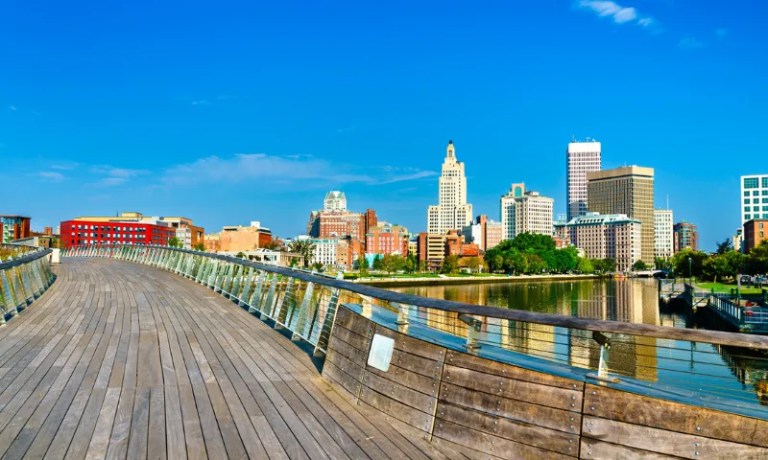The real cost of bottled water.
See how our bottleless water coolers compare.
Areas served
Offer a more sustainable solution for cleaner, better-tasting water on demand.
Fast, efficient, and reliable ice and water machines with advanced filtration.
Bottomless bubbles with built-in filtration for your modern workplace.
Better water makes better coffee. Give your people great-tasting coffee from best-in-class brewers.


Providence drinking water comes from surface water reservoirs located in a 93-square-mile forested watershed basin in Scituate, Rhode Island. Water comes from six interconnected reservoirs: the Scituate Reservoir, Regulating Reservoir, Barden Reservoir, Ponaganset Reservoir, Westconnaug Reservoir, and Moswansicut Reservoir.
The Providence Water system consists of approximately 1,040 miles of transmission and distribution mains, some more than a century old. Once the industry standard, older cast iron pipes are prone to corrosion and biofilm contamination, which create clusters of bacteria along the inside of the pipe. These growths often break off and travel through your pipes, resulting in cloudiness and off-taste.
Providence Water cannot control the materials used in residential plumbing, and according to a recent Providence Water Quality report, Providence Water received a violation in 2019 for failure to report one of 385 lead and copper results to sampled households within 30 days.
Likewise, in drawing water from reservoirs, the city faces certain challenges in satisfying Providence, RI residents. As water travels through and over the land, it picks up naturally occurring minerals and animal or human pollution. This often manifests as a musty or earthy odor or taste, especially after construction or lots of rain.
As far back as the 17th century, Providence residents have made their homes along the eastern bank of the Providence River. Originally only available from private wells, Providence drinking water was first distributed to families in 1773 through an underground system of hollowed out wooden logs. As the population swelled in the 19th century, city planners had to develop a more sophisticated distribution system. Constructed in 1871, Providence’s first water pumping system carried water directly from the Pawtuxet River without any purification or treatment.
Filtration would come later, in 1906, in the form of a slow sand system. Yet, fear of water shortage was ever present, and the need for water storage became apparent. So, in 1915, Providence installed its first reservoir, Scituate Reservoir, still a staple of the city’s water today.
See how our bottleless water coolers compare.
Talk to an Providence Culligan Quench water expert to find the best water solution for your space.
Backed by 85 years of Culligan expertise, Culligan Quench has focused exclusively on providing businesses with the highest quality filtered water. This commitment to doing one thing well has made us the trusted water authority for over 75% of the Fortune 500. We offer the best bottleless water coolers, ice machines, sparkling water dispensers, and coffee brewers to fit any workplace. No matter your location, company size, or industry, we have a filtered water solution that is right for you
Play videoProudly providing businesses with clean, filtered drinking water in the greater Providence Metro Area.
| Mon: | 8 AM – 8PM |
| Tues: | 8 AM – 8PM |
| Wed: | 8 AM – 8PM |
| Thur: | 8 AM – 8PM |
| Fri: | 8 AM – 8PM |
| Sat: | Closed |
| Sun: | Closed |
Yes, you can drink the tap water in Providence, Rhode Island. The city pulls water from the Scituate Reservoir and purifies it thoroughly in a local water treatment plant. The plant uses a variety of processes, including aeration, filtration, pH adjustment, and fluoridation, to ensure the water is safe to drink. All the city’s drinking water meets or exceeds the standards listed in the Safe Drinking Water Act.
While the State of Rhode Island Department of Health regulates water quality, older service lines and the pipes in individual buildings may affect the water that comes out of your tap. The state has audited service lines; check your building’s status on the Public Transparency Dashboard. If you’re concerned, you can also install a point-of-source water cooler that filters water on demand.
Providence has soft water, which means that it has a low mineral concentration. That’s good news for your business. It means you don’t need to worry about buildup or limescale. Bear in mind that soft water sometimes has a higher sodium content than normal, which could be a concern for employees with certain health conditions. A reverse osmosis (RO) water filtration system can help reduce sodium levels and create safer drinking water for everyone in the facility.
Polyfluorinated substances (PFAS) have been found in Rhode Island’s drinking water, but not in all areas. As a result, the state changed its regulations to address the issue. As of September 18, 2024, PFAS levels in public drinking water must be less than 20 parts per trillion (ppt). The state continues to monitor levels.
Drinking water is the major source of exposure to PFAS. Because PFAS from water can build up in the body over time, you might opt to install a water filter with advanced carbon or reverse osmosis filtration.
Over 120,000 companies, big and small, trust Culligan Quench for cleaner, safer, and great-tasting water.
"Water is great
"Culligan Quench is one of the easiest, quickest, smartest
Ready to upgrade
your water?Get matched with the best water, ice, sparkling water or coffee machine for your workplace.
Take our quiz